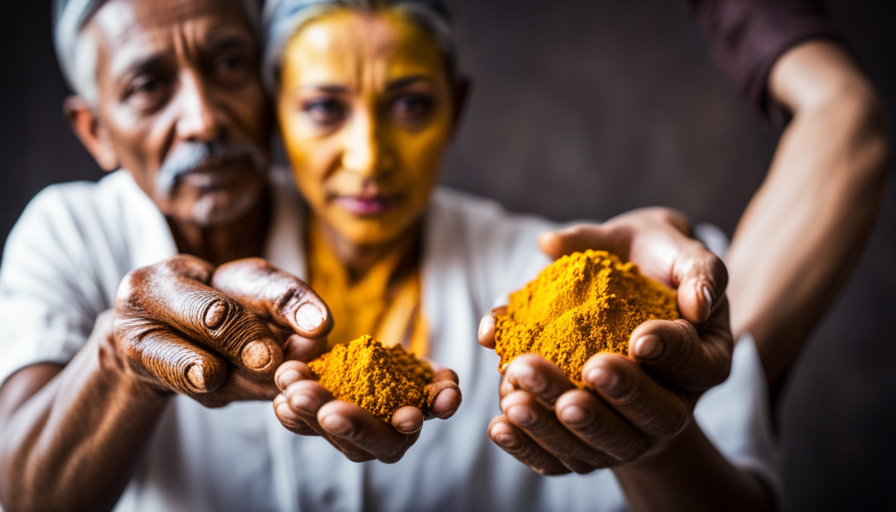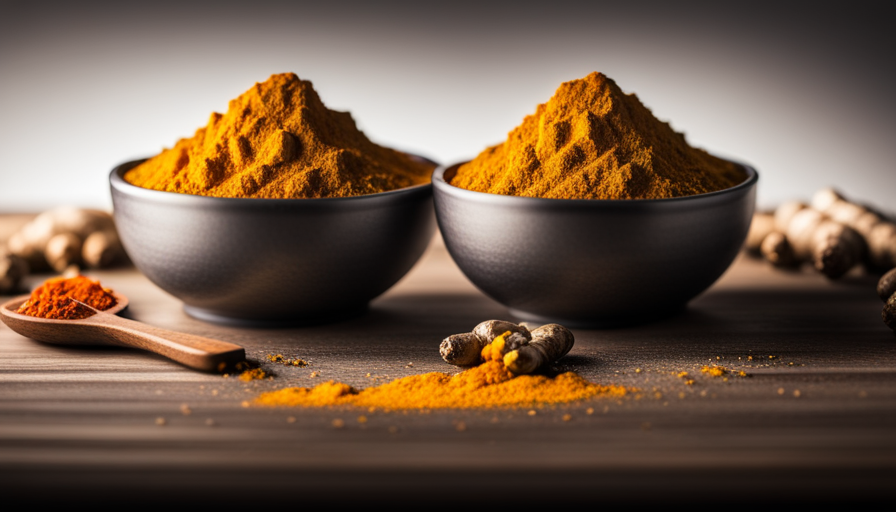Imagine waking up every morning to a clear, radiant complexion, free from the pesky dark spots that have been plaguing you for far too long. You’ve tried countless products, but nothing seems to work. Well, I have great news for you – the solution may be as close as your kitchen spice rack.
Turmeric, a vibrant yellow spice with a rich history in traditional medicine, has been touted for its potential to fade dark spots and even out skin tone. But how long does it actually take for turmeric to work its magic?
In this article, we will explore the properties of turmeric, the various application methods, and the factors that can influence its effectiveness. We will also delve into the recommended turmeric regimen, potential side effects, and precautions to take.
So, get ready to discover the power of turmeric and incorporate it into your skincare routine for a glowing, spot-free complexion.
Key Takeaways
- Turmeric can fade dark spots and even out skin tone.
- Consistency and frequency of turmeric use are important for optimal results.
- Individual variations in skin type and condition can affect how quickly turmeric works on dark spots.
- Results may vary and it may take several weeks or months to see a visible difference.
Understanding the Properties of Turmeric
You’ll be amazed at how quickly turmeric works its magic on those stubborn dark spots! Turmeric is a potent spice that’s been used for centuries in traditional medicine for its numerous health benefits. Its active compound, curcumin, possesses powerful antioxidant and anti-inflammatory properties, making it an excellent remedy for various skin issues, including dark spots.
One of the key benefits of turmeric is its ability to inhibit the production of melanin, the pigment responsible for dark spots. By reducing melanin production, turmeric helps fade existing dark spots and prevents the formation of new ones. Additionally, turmeric’s anti-inflammatory properties help calm the skin and reduce redness, further enhancing its effectiveness in treating dark spots.
To maximize the benefits of turmeric for dark spots, it’s important to use it in the right way. There are several application methods you can choose from, such as creating a turmeric paste by mixing it with water or other natural ingredients like honey or lemon juice. This paste can be applied directly to the dark spots and left on for 15-20 minutes before rinsing off. Other options include using turmeric-infused oils or incorporating turmeric into your skincare routine.
By understanding the properties of turmeric and utilizing the right application methods, you can harness the power of this natural ingredient to effectively reduce the appearance of dark spots.
Turmeric Application Methods
Try applying turmeric using different methods to see which one gives you the best results for your skin concerns.
Turmeric can be applied topically or ingested to reap its numerous benefits. Topical application involves creating a paste by mixing turmeric powder with water or other ingredients like honey or yogurt. This paste can be applied directly to the affected areas and left on for about 10-15 minutes before rinsing off. For a more intense treatment, you can leave the paste on overnight and wash it off in the morning.
Another option is to use turmeric oil, which can be diluted with a carrier oil and applied directly to the skin.
When it comes to ingesting turmeric, it’s important to consult with a healthcare professional for the appropriate dosage. Turmeric supplements or adding turmeric powder to your food can provide you with the benefits of this powerful spice from the inside out.
Now that you know different methods of applying turmeric, let’s explore the timeframe for visible results.
Timeframe for Visible Results
When it comes to seeing visible results from using turmeric for dark spots, it’s important to understand that individual variations in skin type and condition play a significant role.
Some people may notice improvements in as little as a few weeks, while others may take longer to see a difference. Consistency and frequency of turmeric use also matter, as regular application is key to achieving desired results.
Finally, it’s important to have patience and maintain realistic expectations, as turmeric is not a quick fix and it may take some time before noticeable changes occur.
Individual variations in skin type and condition
Although everyone’s skin is different, the effects of turmeric on dark spots can vary depending on individual variations in skin type and condition. Individual differences in skin type, such as dryness, oiliness, or sensitivity, can affect how quickly turmeric works on dark spots. Additionally, the condition of the skin, including the severity of the dark spots and overall skin health, can also impact the timeframe for visible results.
To give you a better understanding of these variations, here is a table showcasing how different skin types and conditions may influence the effectiveness of turmeric on dark spots:
| Skin Type | Skin Condition | Timeframe for Visible Results |
|---|---|---|
| Dry | Mild Dark Spots | Longer than average |
| Oily | Severe Dark Spots | Quicker than average |
| Sensitive | Uneven Skin Tone | Similar to average |
Understanding these individual differences can help you determine the appropriate consistency and frequency of turmeric use for your specific skin type and condition. Transitioning into the next section, let’s explore the importance of consistency and frequency in achieving optimal results with turmeric.
Consistency and frequency of turmeric use
Maintaining a regular routine of using turmeric can yield optimal results for your skin. Turmeric effectiveness is dependent on consistency and frequency of use. Applying turmeric regularly can help fade dark spots and improve overall skin tone.
The active ingredient in turmeric, curcumin, has powerful antioxidant and anti-inflammatory properties, which can help reduce hyperpigmentation and promote a more even complexion. By using turmeric consistently, you can harness the benefits of turmeric and see noticeable improvements in your dark spots over time. However, it’s important to have patience and realistic expectations.
While turmeric can be effective, results may vary depending on individual factors such as skin type and the severity of the dark spots. Transitioning to the next section, it’s crucial to understand the role of patience and realistic expectations in achieving desired results.
Patience and realistic expectations
Be patient and set realistic expectations for achieving your desired results with turmeric. Understanding the benefits and limitations of this natural remedy is crucial in managing expectations.
Turmeric contains a compound called curcumin, which has anti-inflammatory and antioxidant properties that can help fade dark spots over time. However, it’s important to remember that turmeric isn’t a magical overnight solution. Results vary from person to person, and it may take several weeks or even months of consistent use to notice a visible difference in your dark spots. Factors such as the severity of the spots, skin type, and individual response to turmeric can also influence the effectiveness.
So, while turmeric can be an effective tool for fading dark spots, it’s essential to be patient and consistent in your usage.
Transitioning into the next section, let’s explore the factors that influence the effectiveness of turmeric.
Factors that Influence the Effectiveness of Turmeric
To see the best results for dark spots, you’ll want to consider factors that can influence how effective turmeric is. One important factor is the dosage of turmeric you’re taking. Taking too little may not provide the desired results, while taking too much can have negative side effects. It’s recommended to start with a small dosage and gradually increase it, while monitoring the effects on your skin.
Another factor to consider is the absorption of turmeric in your body. Turmeric contains a compound called curcumin, which has low bioavailability. This means that your body might not be able to absorb it effectively. To enhance the absorption, you can consume turmeric with black pepper, as it contains a compound called piperine that enhances curcumin absorption.
Additionally, the overall health of your skin plays a role in the effectiveness of turmeric for dark spots. If your skin is dry or damaged, it may take longer for the turmeric to work its magic. It’s important to keep your skin moisturized and well-nourished to maximize the benefits of turmeric.
To achieve the best results with turmeric for dark spots, it’s important to consider factors such as the dosage, absorption, and overall skin health. By taking these factors into account, you can optimize the effectiveness of turmeric in reducing dark spots and achieving a more even skin tone. Now, let’s move on to the recommended turmeric regimen.
Recommended Turmeric Regimen
When it comes to creating a turmeric regimen, there are a few key points to keep in mind. First, it’s essential to prepare a turmeric paste or mask for effective application. Second, knowing the proper application techniques and tips can enhance the overall effectiveness. Lastly, understanding the duration of application and removal is crucial for achieving desired results.
By following these recommendations, you can maximize the benefits of turmeric for your dark spots.
Preparing turmeric paste or mask
Using turmeric to prepare a paste or mask is an absolute game-changer for fading those stubborn dark spots! Turmeric has numerous benefits for the skin, including its anti-inflammatory and antioxidant properties.
To make a turmeric paste or mask, follow these simple steps:
- Mix 1 tablespoon of turmeric powder with 2 tablespoons of yogurt or milk to create a thick paste.
- Add a few drops of honey to enhance the moisturizing properties.
- Apply the paste to the affected areas and leave it on for 15-20 minutes.
- Rinse off with warm water and pat dry.
- Repeat this process 2-3 times a week for best results.
Turmeric recipes for dark spots can also include ingredients like lemon juice, aloe vera, or rosewater for added benefits.
With regular use, this turmeric paste or mask can gradually lighten dark spots and even out skin tone.
Now, let’s move on to application techniques and tips for maximizing the effectiveness of turmeric for dark spots.
Application techniques and tips
Ready to level up your turmeric game? Let’s dive into some application techniques and tips that will take your dark spot fading routine to the next level! When it comes to applying turmeric paste or mask, there are a few things to keep in mind for maximum effectiveness. First, make sure to cleanse your face thoroughly before application to remove any dirt or oil. This will allow the turmeric to penetrate the skin better. Secondly, use gentle circular motions to massage the paste onto your skin, focusing on the areas with dark spots. Lastly, leave the turmeric paste on for about 15-20 minutes before rinsing off with warm water. This will give the turmeric enough time to work its magic. By following these techniques and tips, you can maximize the turmeric benefits and enhance the effectiveness of alternative remedies. Now, let’s move on to the next section where we will discuss the duration of application and removal.
Duration of application and removal
To fully experience the transformative power of turmeric, let the paste sit on your skin like sunshine on a summer’s day, allowing it to infuse its golden glow into your complexion.
The duration of application for a turmeric mask can vary depending on your skin type and sensitivity. It’s generally recommended to leave the mask on for about 15-20 minutes. During this time, the active compounds in turmeric, such as curcumin, work their magic to reduce inflammation, lighten dark spots, and even out skin tone.
After the recommended time, gently remove the mask with warm water and a soft cloth. It’s important to note that the effectiveness of turmeric for dark spots may vary from person to person, and consistent application over time is key to achieving noticeable results.
Transitioning into combining turmeric with other natural remedies, we can enhance its benefits and further improve the appearance of dark spots.
Combining Turmeric with Other Natural Remedies
When combining turmeric with other natural remedies, it’s like creating a powerful army of ingredients to combat dark spots. Not only does turmeric have its own skin-brightening properties, but when combined with other remedies, it can enhance its effectiveness even further.
Here are a few natural ingredients that can be combined with turmeric to maximize its benefits:
-
Aloe vera: This soothing plant is known for its moisturizing and healing properties. When combined with turmeric, it can help reduce inflammation and promote skin regeneration, making it an excellent addition to any dark spot treatment.
-
Lemon juice: The citric acid in lemon juice acts as a natural exfoliant, helping to remove dead skin cells and fade dark spots. When mixed with turmeric, it can create a potent brightening mask.
-
Honey: Known for its antibacterial and moisturizing properties, honey can help soothe and hydrate the skin. When combined with turmeric, it can create a nourishing mask that promotes a healthy complexion.
-
Yogurt: The lactic acid in yogurt helps to gently exfoliate the skin, revealing a brighter and more even complexion. When mixed with turmeric, it can help fade dark spots and improve overall skin tone.
By incorporating these natural remedies with turmeric, you can create a powerful treatment for dark spots. However, it’s important to use caution when using turmeric on the skin, as it can stain clothing and temporarily tint the skin yellow. Additionally, some individuals may be allergic to turmeric, so it’s always best to do a patch test before applying it to your face.
Moving on to potential side effects and precautions…
Potential Side Effects and Precautions
When using turmeric for skincare, it’s important to be aware of potential side effects and take necessary precautions.
Allergic reactions and skin sensitivity can occur, so it’s recommended to perform a patch test before applying it fully.
If you have specific concerns or pre-existing skin conditions, it’s advisable to consult a dermatologist for personalized advice and guidance.
Allergic reactions and skin sensitivity
Although turmeric is known for its effectiveness in reducing dark spots, it’s important to be aware of any potential allergic reactions or skin sensitivity that may occur.
Some individuals may experience an allergic reaction to turmeric, which can manifest as redness, itching, or swelling of the skin. Those with sensitive skin may also be more prone to irritation when using turmeric topically.
It is recommended to perform a patch test before applying turmeric to the entire affected area. This involves applying a small amount of turmeric paste or diluted turmeric oil to a small area of skin and monitoring for any adverse reactions for 24 hours. If no negative reactions occur, it is generally safe to proceed with using turmeric for dark spots.
Transitioning into the next section, patch testing before full application can help determine if turmeric is suitable for your skin.
Patch testing before full application
Before slathering turmeric all over your face, it’s crucial to patch test first to ensure that it won’t cause any adverse reactions on your skin. Patch testing is especially important for individuals with sensitive skin, as it helps identify any potential allergens or irritants that may trigger a negative response. Skipping this step can lead to various risks, including redness, itching, swelling, or even a full-blown allergic reaction.
To properly patch test turmeric, follow these steps:
-
Cleanse and dry a small area of skin, preferably on your inner forearm.
-
Apply a small amount of turmeric paste or solution to the patch test area.
-
Cover the area with a bandage and leave it on for 24-48 hours.
-
Monitor the patch test area for any signs of irritation or allergic reaction.
By taking the time to patch test, you can ensure the safety of using turmeric on your skin. If you have any specific concerns or experience negative reactions, it’s always best to consult a dermatologist for further guidance.
Now, let’s delve into the importance of consulting a dermatologist for specific concerns.
Consulting a dermatologist for specific concerns
If you have specific concerns about your skin, it’s crucial to consult a dermatologist for expert guidance. They can provide personalized recommendations based on your individual needs and concerns.
A dermatologist will be able to assess the severity of your dark spots and determine the best course of action for you. They may recommend alternative treatment options in addition to or instead of using turmeric. These options could include topical creams, laser treatments, or chemical peels, depending on the nature of your dark spots.
It’s important to remember that everyone’s skin is unique, and what works for one person may not work for another. Therefore, seeking professional advice is essential for achieving the best results.
Incorporating turmeric into your skincare routine can be a beneficial step in addressing dark spots, but it’s important to do so in consultation with a dermatologist.
Incorporating Turmeric into Your Skincare Routine
To effectively incorporate turmeric into your skincare routine, you should consider its potential to gradually fade dark spots over time. Turmeric has numerous benefits for the skin, and its natural properties can help lighten hyperpigmentation caused by dark spots. Here are four ways you can incorporate turmeric into your skincare routine:
-
Turmeric face mask: Mix a teaspoon of turmeric powder with honey and yogurt to create a paste. Apply it to your face and leave it on for 15-20 minutes before rinsing off. This mask can help reduce the appearance of dark spots and brighten your complexion.
-
Turmeric scrub: Combine turmeric powder with a gentle exfoliant like sugar or oatmeal. Gently massage the mixture onto your skin to slough off dead cells and reveal a more even skin tone.
-
Turmeric-infused moisturizer: Add a pinch of turmeric powder to your regular moisturizer and apply it to your face daily. This can help fade dark spots gradually over time.
-
Turmeric tea: Drinking turmeric tea can provide antioxidant benefits to your skin from the inside out, promoting a healthy complexion and potentially aiding in the fading of dark spots.
Incorporating turmeric into your skincare routine is just one step in achieving the desired results. In the next section, we’ll discuss lifestyle and dietary factors that can further enhance the effectiveness of turmeric in fading dark spots without relying solely on turmeric-infused products.
Lifestyle and Dietary Factors for Enhancing Results
Incorporating turmeric into your skincare routine can be a game-changer when it comes to fading dark spots. However, for optimal results, it’s important to consider lifestyle modifications and dietary considerations.
Making certain changes to your daily routine and eating habits can enhance the effectiveness of turmeric in treating dark spots.
Firstly, maintaining a healthy lifestyle is crucial. Regular exercise improves blood circulation, which helps deliver the healing properties of turmeric to your skin more efficiently. Additionally, managing stress levels through activities like yoga or meditation can prevent the release of stress hormones that can exacerbate dark spots.
Dietary considerations are also essential in maximizing the benefits of turmeric. Incorporating foods that are rich in antioxidants, such as berries, leafy greens, and nuts, can support the healing process and minimize the appearance of dark spots. Moreover, avoiding processed foods and reducing sugar intake can prevent inflammation, which can contribute to the formation of dark spots.
By making these lifestyle modifications and dietary changes, you can enhance the efficacy of turmeric in fading dark spots. But, how long does it take for turmeric to work its magic? Let’s delve into long-term maintenance and prevention to find out.
Long-term Maintenance and Prevention
To maintain clear and radiant skin, it’s essential that you prioritize consistent and healthy lifestyle habits as well as incorporate turmeric into your skincare routine. While turmeric can provide noticeable results for dark spots, it’s important to understand that long-term maintenance and prevention are equally important.
In addition to using turmeric topically, you may also consider taking turmeric supplements to enhance its effects on your skin. These supplements can provide a concentrated dose of the active compounds found in turmeric, such as curcumin, which have been shown to have anti-inflammatory and antioxidant properties. Incorporating turmeric supplements into your daily routine can help support overall skin health and reduce the appearance of dark spots.
Furthermore, it’s worth exploring alternative remedies that can complement the use of turmeric. For example, incorporating other natural ingredients like aloe vera, lemon juice, or honey into your skincare routine can help further lighten dark spots and promote a more even skin tone. These remedies can be used in conjunction with turmeric to enhance its effectiveness and provide a comprehensive approach to maintaining clear and radiant skin.
Remember, consistency is key when it comes to achieving and maintaining results. By incorporating turmeric supplements and exploring alternative remedies, you can optimize the benefits of turmeric for your skin and enjoy long-term improvement in the appearance of dark spots.
Frequently Asked Questions
Can turmeric be used on all skin types?
Yes, turmeric can be used on all skin types. It’s known for its anti-inflammatory and antioxidant properties, making it a popular ingredient in skincare. Turmeric can help reduce inflammation and bacterial growth, promoting clearer skin for acne. It can also effectively treat hyperpigmentation by inhibiting excess melanin production. Its versatility and gentle nature make it suitable for all skin types.
Can turmeric help with other skin concerns besides dark spots?
Oh, the wonders of turmeric! Not only does it work wonders for dark spots, but it also offers relief for other skin concerns.
Turmeric has been hailed for its ability to combat acne, thanks to its anti-inflammatory and antibacterial properties. Additionally, it can help with hyperpigmentation, reducing the appearance of uneven skin tone.
Incorporating turmeric into your skincare routine can be a game-changer for addressing these common skin issues.
Are there any specific brands or types of turmeric that are more effective for treating dark spots?
When it comes to treating dark spots, turmeric can be an effective option due to its numerous benefits and uses. However, there isn’t a specific brand or type of turmeric that’s more effective for treating dark spots. The effectiveness of turmeric in reducing dark spots may vary depending on individual factors such as skin type and severity of the dark spots. It’s recommended to consult with a dermatologist for personalized advice and treatment options.
Can turmeric be used as a spot treatment for individual dark spots, or should it be applied to the entire face?
Turmeric can be used as a spot treatment for individual dark spots, or it can be applied to the entire face. When using turmeric as a spot treatment, apply a paste directly onto the dark spots and leave it on for about 15-20 minutes before rinsing off. This method can help to reduce the appearance of hyperpigmentation. However, it’s important to note that results may vary depending on the individual and consistency is key when using turmeric for hyperpigmentation.
How often should turmeric be applied to see the best results for dark spots?
To achieve the best results in fading dark spots, it’s important to apply turmeric consistently and at the recommended frequency. Applying turmeric to the affected areas of the skin on a daily basis can help accelerate the lightening process.
For optimal results, it’s advisable to continue this application for a period of at least several weeks. By doing so, the potent properties of turmeric can effectively target and reduce the appearance of dark spots.
Conclusion
In conclusion, after investigating the truth of the theory, it’s clear that turmeric can be an effective remedy for dark spots. With its anti-inflammatory and antioxidant properties, turmeric can help fade dark spots over time. However, the timeframe for visible results may vary depending on factors such as skin type, severity of the dark spots, and consistency of turmeric application.
It’s important to follow a recommended turmeric regimen, be aware of potential side effects, and incorporate turmeric into a skincare routine alongside lifestyle and dietary factors for enhanced results. Remember, long-term maintenance and prevention are key to achieving and maintaining a clear, even-toned complexion.










